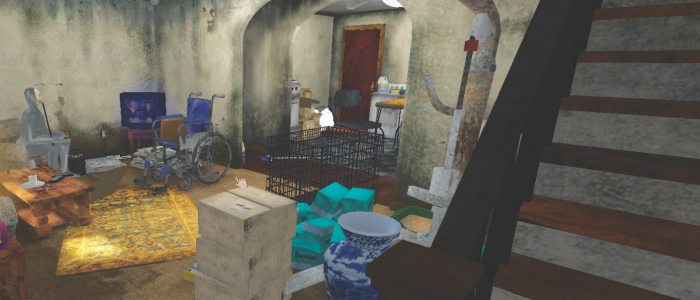Home health care providers are able to identify household threats to the health of patients, their family or themselves within a virtual training environment funded by the National Institute for Occupational Safety and Health.
Virtual environments, once seen only as a unique extension of gaming technology, now are considered essential tools for competitiveness, from healthcare to education to manufacturing. The Ohio Supercomputer Center’s Virtual Environments and Simulation Group use this technology to create rich, precise, interactive simulations for training, assessment and remote collaborations.
“Our forte is surgical simulation,” said Don Stredney, as he reflected on the advances of interactive simulations during his 20-plus years as director of the Interface Lab. “Our work on simulating temporal bone surgery for training is extensible to other areas, such as preoperative assessment and surgical planning, exploration of new surgical approaches, or applications beyond communication disorders.
Virtual Temporal Bone Project
We’ve accumulated well over 10 years of research on this National Institutes of Health RO1 project. (The project allows medical students and residents to practice delicate drill techniques on the skull, via a computer-based teaching system.)
We integrate the vast amounts of real-time multisensory data sets into a single, coherent simulation. The key is that we must execute what we are computing in real-time. It is fairly horrendous in terms of computation, but it has to be solved instantaneously for accurate training purposes. We’ve also been successful with remote rendering. This enables the visualization algorithms to be calculated at the Ohio Supercomputer Center, with just the resulting images delivered back to a hand-held device, such as an iPad.
We are establishing reliable, accurate and effective means of evaluating a student’s technical skills using a simulator; this is a strong point of our work. By creating a composite dataset of the drill techniques used by our surgical partners at each of our 11 study sites around the United States, we established an “expert dataset” to use as a benchmark for evaluating residents.
Expanding Our Reach
We are collaborating with a variety of researchers within OSC and beyond to extend this technology.
For example, the University of Cincinnati’s Ravi Samy, MD, is transferring temporal bone simulations to a robot, to test methods for improving the surgical precision. At The Ohio State University’s College of Veterinary Medicine, researchers are looking at remote rendering as an option for students to study anatomy on demand, outside of the lab.
OSC’s home health care training simulation, funded by NIOSH (the National Institute for Occupational Safety and Health) is being evaluated to help workers identify household risks for patients or health care workers themselves, such as mold, dangerous use of equipment or other injury producing events. Meanwhile, our Mammoth Cave project enables geology students, especially those with motion disabilities, to explore the geological structures of the cave.
Finally, The Ohio State University Driving Simulation Laboratory studies how drivers use vehicle instrument panels and in-vehicle information systems. The lab was established through collaborations with Honda R&D Americas, oversight from Ohio State’s Office of Research and technical expertise from OSC.

